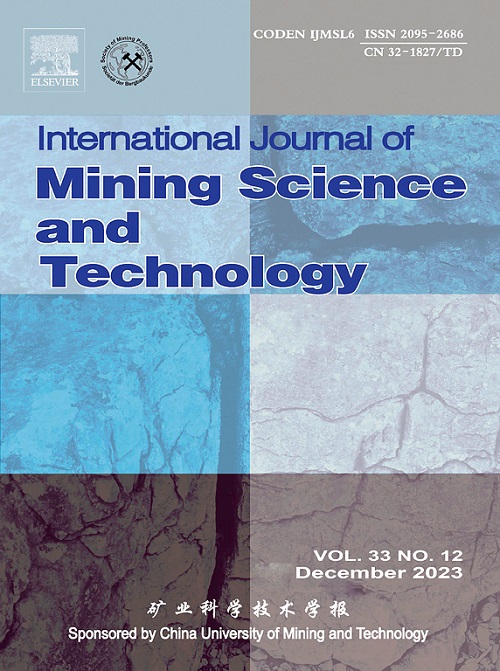Dynamic interpretation of stress adjustment types in high geostress hard rock tunnels based on microseismic monitoring
IF 13.7
1区 工程技术
Q1 MINING & MINERAL PROCESSING
International Journal of Mining Science and Technology
Pub Date : 2025-05-01
DOI:10.1016/j.ijmst.2025.04.004
引用次数: 0
Abstract
Dynamic stress adjustment in deep-buried high geostress hard rock tunnels frequently triggers catastrophic failures such as rockbursts and collapses. While a comprehensive understanding of this process is critical for evaluating surrounding rock stability, its dynamic evolution are often overlooked in engineering practice. This study systematically summarizes a novel classification framework for stress adjustment types—stabilizing (two-zoned), shallow failure (three-zoned), and deep failure (four-zoned)—characterized by distinct stress adjustment stages. A dynamic interpretation technology system is developed based on microseismic monitoring, integrating key microseismic parameters (energy index EI, apparent stress , microseismic activity S), seismic source parameter space clustering, and microseismic paths. This approach enables precise identification of evolutionary stages, stress adjustment types, and failure precursors, thereby elucidating the intrinsic linkage between geomechanical processes (stress redistribution) and failure risks. The study establishes criteria and procedures for identifying stress adjustment types and their associated failure risks, which were successfully applied in the Grand Canyon Tunnel of the E-han Highway to detect 50 instances of disaster risks. The findings offer invaluable insights into understanding the evolution process of stress adjustment and pinpointing the disaster risks linked to hard rock in comparable high geostress tunnels.
基于微震监测的高地应力硬岩隧道应力调整类型动态解释
深埋高地应力硬岩隧道的动应力调整经常引发岩爆、崩塌等灾难性破坏。虽然全面了解这一过程对评价围岩稳定性至关重要,但在工程实践中往往忽视其动态演化。本文系统总结了以不同应力调整阶段为特征的应力调整类型分类框架:稳定型(2区)、浅层破坏型(3区)和深部破坏型(4区)。基于微震监测,综合微震关键参数(能量指数EI、视应力σa、微震活度S)、震源参数空间聚类和微震路径,构建了微震动态解释技术体系。这种方法能够精确识别演化阶段、应力调整类型和破坏前兆,从而阐明地质力学过程(应力重分布)与破坏风险之间的内在联系。研究建立了应力调整类型及其相关破坏风险的识别标准和程序,并成功应用于E-han高速公路大峡谷隧道50例灾害风险的检测。这些发现为理解应力调整的演化过程和精确定位与高地应力隧道中硬岩相关的灾害风险提供了宝贵的见解。
本文章由计算机程序翻译,如有差异,请以英文原文为准。
求助全文
约1分钟内获得全文
求助全文
来源期刊

International Journal of Mining Science and Technology
Earth and Planetary Sciences-Geotechnical Engineering and Engineering Geology
CiteScore
19.10
自引率
11.90%
发文量
2541
审稿时长
44 days
期刊介绍:
The International Journal of Mining Science and Technology, founded in 1990 as the Journal of China University of Mining and Technology, is a monthly English-language journal. It publishes original research papers and high-quality reviews that explore the latest advancements in theories, methodologies, and applications within the realm of mining sciences and technologies. The journal serves as an international exchange forum for readers and authors worldwide involved in mining sciences and technologies. All papers undergo a peer-review process and meticulous editing by specialists and authorities, with the entire submission-to-publication process conducted electronically.
 求助内容:
求助内容: 应助结果提醒方式:
应助结果提醒方式:


